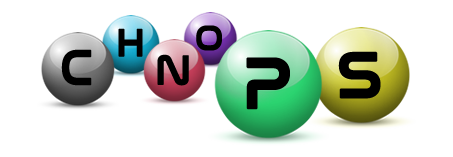CHNOPS
The six most common elements in all living things are Carbon (C), Hydrogen (H), Nitrogen (N), Oxygen (O), Phosphorus (P), and Sulfur (S). They are often abbreviated as CHNOPS. Elements are defined by the number of protons they have (Isotopes make the same element differ in weight since an Isotope is defined by the number of Neutrons contained within a given element). These six elements are very good at constructing complex biomolecules, the molecules involved in life. They also make up organic molecules, all of which contain carbon and hydrogen, and inorganic molecules, which lack carbon.

Carbon
Carbon is the sixth element on the periodic table and forms strong covalent bonds (where electrons are shared between two atoms) Carbon can bond with up to four atoms at the same time. Therefore, many kinds of molecules can be created from carbon. Along with the other five elements (H, N, O, P, & S) Carbon makes up carbohydrates, proteins, nucleic acids, and lipids. From a molecules like methane (CH4) to complex molecules like long hydrocarbons (such as those found in fossil fuels) carbon’s versatility proves that it is essential to all life as we know it.
Hydrogen
Hydrogen is the first element on the periodic table. It is a simple element with the ability to form a single bond with a negatively charged atom. Hydrogen bonds are crucial to life because these bonds are essential to form water (H2O). Water forms when two Hydrogens bond with one oxygen. Hydrogen can also attach (bond) with carbon, creating long hydrocarbon chains that make up carbohydrates and lipids, as well as to nitrogen and other common elements to make up nucleic acids and proteins.
Nitrogen
Nitrogen is the seventh element on the periodic table. It bonds well to carbon and hydrogen and is therefore involved in the assembly of a variety of organic compounds. Nitrogen is the main element that makes up proteins and nucleic acids. Nitrogen is vitally important to DNA molecules, since the structure of the DNA molecule is built from protein and nucleic acid molecules.
Oxygen
Oxygen is the eighth element on the periodic table. With hydrogen, oxygen makes up water. Therefore, Oxygen is a vital element found in living organisms. Oxygen is also found in organic molecules and is heavily involved in the metabolism of energy in even the simplest cell structures. Oxygen is not required for all organisms on Earth to survive (some microorganisms thrive in the absence of oxygen), however, oxygen is still present in those organisms in the form of water and organic molecules.
Phosphorus
Phosphorus is the fifteenth element on the periodic table. Phosphorus can be found in the backbone of the DNA molecule. Phosphorus has a vital role in energy metabolism since it makes up a cell’s energy currency molecules. These molecules are ATP and ADP, each named for the number of phosphate atoms attached: adenosine tri-phosphate (ATP, 3 Phosphate atoms) and adenosine di-phosphate (ADP, 2 Phosphate atoms).
Sulfur
Sulfur is the sixteenth element on the periodic table. It is the heaviest of the basic six elements. It is primarily found in protein molecules, and their bonds are responsible for giving proteins their different shapes. Protein shapes are very important. They are important because protein function and specificity are dependent on their geometry (shape).
